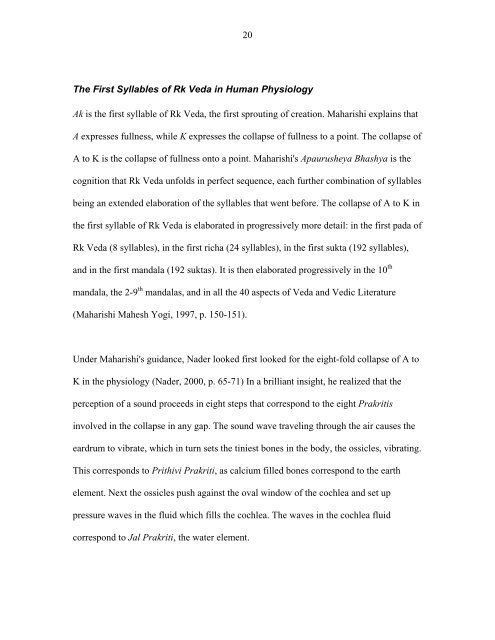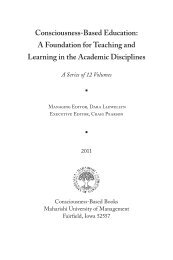Research Proposal for the Doctoral Program in Maharishi Vedic ...
Research Proposal for the Doctoral Program in Maharishi Vedic ...
Research Proposal for the Doctoral Program in Maharishi Vedic ...
Create successful ePaper yourself
Turn your PDF publications into a flip-book with our unique Google optimized e-Paper software.
20The First Syllables of Rk Veda <strong>in</strong> Human PhysiologyAk is <strong>the</strong> first syllable of Rk Veda, <strong>the</strong> first sprout<strong>in</strong>g of creation. <strong>Maharishi</strong> expla<strong>in</strong>s thatA expresses fullness, while K expresses <strong>the</strong> collapse of fullness to a po<strong>in</strong>t. The collapse ofA to K is <strong>the</strong> collapse of fullness onto a po<strong>in</strong>t. <strong>Maharishi</strong>'s Apaurusheya Bhashya is <strong>the</strong>cognition that Rk Veda unfolds <strong>in</strong> perfect sequence, each fur<strong>the</strong>r comb<strong>in</strong>ation of syllablesbe<strong>in</strong>g an extended elaboration of <strong>the</strong> syllables that went be<strong>for</strong>e. The collapse of A to K <strong>in</strong><strong>the</strong> first syllable of Rk Veda is elaborated <strong>in</strong> progressively more detail: <strong>in</strong> <strong>the</strong> first pada ofRk Veda (8 syllables), <strong>in</strong> <strong>the</strong> first richa (24 syllables), <strong>in</strong> <strong>the</strong> first sukta (192 syllables),and <strong>in</strong> <strong>the</strong> first mandala (192 suktas). It is <strong>the</strong>n elaborated progressively <strong>in</strong> <strong>the</strong> 10 thmandala, <strong>the</strong> 2-9 th mandalas, and <strong>in</strong> all <strong>the</strong> 40 aspects of Veda and <strong>Vedic</strong> Literature(<strong>Maharishi</strong> Mahesh Yogi, 1997, p. 150-151).Under <strong>Maharishi</strong>'s guidance, Nader looked first looked <strong>for</strong> <strong>the</strong> eight-fold collapse of A toK <strong>in</strong> <strong>the</strong> physiology (Nader, 2000, p. 65-71) In a brilliant <strong>in</strong>sight, he realized that <strong>the</strong>perception of a sound proceeds <strong>in</strong> eight steps that correspond to <strong>the</strong> eight Prakritis<strong>in</strong>volved <strong>in</strong> <strong>the</strong> collapse <strong>in</strong> any gap. The sound wave travel<strong>in</strong>g through <strong>the</strong> air causes <strong>the</strong>eardrum to vibrate, which <strong>in</strong> turn sets <strong>the</strong> t<strong>in</strong>iest bones <strong>in</strong> <strong>the</strong> body, <strong>the</strong> ossicles, vibrat<strong>in</strong>g.This corresponds to Prithivi Prakriti, as calcium filled bones correspond to <strong>the</strong> ear<strong>the</strong>lement. Next <strong>the</strong> ossicles push aga<strong>in</strong>st <strong>the</strong> oval w<strong>in</strong>dow of <strong>the</strong> cochlea and set uppressure waves <strong>in</strong> <strong>the</strong> fluid which fills <strong>the</strong> cochlea. The waves <strong>in</strong> <strong>the</strong> cochlea fluidcorrespond to Jal Prakriti, <strong>the</strong> water element.
















